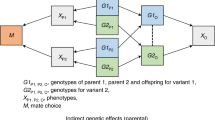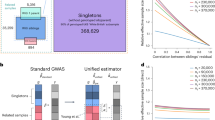Abstract
A common approach to genetic mapping of loci for complex diseases is to perform a genome-wide association study (GWAS) by analyzing a vast number of SNP markers in cohorts of unrelated cases and controls. A direct motivation for the case–control design is that unrelated, affected individuals can be easier to collect than large families with multiple affected persons in the Western world. Despite its higher potential power, investigators have not actively pursued family ascertainment in part because of a dearth of methods for analyzing such correlated data on a large scale. We examine the statistical properties of several commonly used family-based association tests, as to their performance using real-life mixtures of families and singletons taken from our own migraine and schizophrenia studies, as well as population-based data for a complex trait simulated with the evolutionary phenogenetic simulator, ForSim. In virtually every situation, the full likelihood-based methods in the PSEUDOMARKER program outperformed those implemented in FBAT, GENEHUNTER TDT, PLINK (family-based options), HRR/HHRR, QTDT, TRANSMIT, UNPHASED, MENDEL, and LAMP. We further show that GWAS is much more powerful when family samples are used rather than unrelateds, on a genotype-by-genotype basis.
Similar content being viewed by others
Log in or create a free account to read this content
Gain free access to this article, as well as selected content from this journal and more on nature.com
or
References
Pekkarinen P, Hovatta I, Hakola P et al: Assignment of the locus for PLO-SL, a frontal-lobe dementia with bone cysts, to 19q13. Am J Hum Genet 1998; 62: 362–372.
Enattah NS, Sahi T, Savilahti E, Terwilliger JD, Peltonen L, Järvelä I : Identification of a variant associated with adult-type hypolactasia. Nat Genet 2002; 30: 233–237.
Kerem B, Rommens JM, Buchanan JA et al: Identification of the cystic fibrosis gene: genetic analysis. Science 1989; 245: 1073–1080.
Nikali K, Suomalainen A, Terwilliger J, Koskinen T, Weissenbach J, Peltonen L : Random search for shared chromosomal regions in four affected individuals: the assignment of a new hereditary ataxia locus. Am J Hum Genet 1995; 56: 1088–1095.
Hellsten E, Vesa J, Speer MC et al: Refined assignment of the infantile neuronal ceroid lipofuscinosis (INCL, CLN1) locus at 1p32: incorporation of linkage disequilibrium in multipoint analysis. Genomics 1993; 16: 720–725.
Tienari PJ, Terwilliger JD, Ott J, Palo J, Peltonen L : Two-locus linkage analysis in multiple sclerosis (MS). Genomics 1994; 19: 320–325.
Haberhausen G, Schmitt I, Köhler A et al: Assignment of the dystonia-parkinsonism syndrome locus, DYT3, to a small region within a 1.8-Mb YAC contig of Xq13.1. Am J Hum Genet 1995; 57: 644–650.
Raha-Chowdhury R, Bowen DJ, Stone C et al: New polymorphic microsatellite markers place the haemochromatosis gene telomeric to D6S105. Hum Mol Genet 1995; 4: 1869–1874.
Satsangi J, Parkes M, Louis E et al: Two stage genome-wide search in inflammatory bowel disease provides evidence for susceptibility loci on chromosomes 3, 7 and 12. Nat Genet 1996; 14: 199–202.
Hästbacka J, de la Chapelle A, Kaitila I, Sistonen P, Weaver A, Lander E : Linkage disequilibrium mapping in isolated founder populations: diastrophic dysplasia in Finland. Nat Genet 1992; 2: 204–211.
Laird NM, Horvath S, Xu X : Implementing a unified approach to family-based tests of association. Genet Epidemiol 2000; 19 (Suppl 1): S36–S42.
Rabinowitz D, Laird N : A unified approach to adjusting association tests for population admixture with arbitrary pedigree structure and arbitrary missing marker information. Hum Hered 2000; 50: 211–223.
Kruglyak L, Daly MJ, Reeve-Daly MP, Lander ES : Parametric and nonparametric linkage analysis: a unified multipoint approach. Am J Hum Genet 1996; 58: 1347–1363.
Purcell S, Neale B, Todd-Brown K et al: PLINK: a tool set for whole-genome association and population-based linkage analyses. Am J Hum Genet 2007; 81: 559–575.
Terwilliger JD : A powerful likelihood method for the analysis of linkage disequilibrium between trait loci and one or more polymorphic marker loci. Am J Hum Genet 1995; 56: 777–787.
Abecasis GR, Cardon LR, Cookson WO : A general test of association for quantitative traits in nuclear families. Am J Hum Genet 2000; 66: 279–292.
Abecasis GR, Cookson WO, Cardon LR : Pedigree tests of transmission disequilibrium. Eur J Hum Genet 2000; 8: 545–551.
Clayton D : A generalization of the transmission/disequilibrium test for uncertain-haplotype transmission. Am J Hum Genet 1999; 65: 1170–1177.
Dudbridge F : Likelihood-based association analysis for nuclear families and unrelated subjects with missing genotype data. Hum Hered 2008; 66: 87–98.
Lange K, Cantor R, Horvath S et al: Mendel version 4.0: a complete package for the exact genetic analysis of discrete traits in pedigree and population data sets. Am J Hum Genet 2001; 69 (Suppl): 504.
Li M, Boehnke M, Abecasis GR : Joint modeling of linkage and association: identifying SNPs responsible for a linkage signal. Am J Hum Genet 2005; 76: 934–949.
Li M, Boehnke M, Abecasis GR : Efficient study designs for test of genetic association using sibship data and unrelated cases and controls. Am J Hum Genet 2006; 78: 778–792.
Hiekkalinna T, Schäffer AA, Lambert BW, Norrgrann P, Göring HHH, Terwilliger JD : PSEUDOMARKER: a powerful program for joint linkage and/or linkage disequilibrium analysis on mixtures of singletons and related individuals. Hum Hered 2011; 71: 256–266.
Wessman M, Kallela M, Kaunisto MA et al: A susceptibility locus for migraine with aura, on chromosome 4q24. Am J Hum Genet 2002; 70: 652–662.
Kaunisto MA, Tikka PJ, Kallela M et al: Chromosome 19p13 loci in Finnish migraine with aura families. Am J Med Genet B Neuropsychiatr Genet 2005; 132: 85–89.
Ekelund J, Hovatta I, Parker A et al: Chromosome 1 loci in Finnish schizophrenia families. Hum Mol Genet 2001; 10: 1611–1617.
Lambert BW, Terwilliger JD, Weiss KM : ForSim: a tool for exploring the genetic architecture of complex traits with controlled truth. Bioinformatics 2008; 24: 1821–1822.
Spielman RS, McGinnis RE, Ewens WJ : Transmission test for linkage disequilibrium: the insulin gene region and insulin-dependent diabetes mellitus (IDDM). Am J Hum Genet 1993; 52: 506–516.
Terwilliger JD, Ott J : A haplotype-based ‘haplotype relative risk’ approach to detecting allelic associations. Hum Hered 1992; 42: 337–346.
Göring HH, Terwilliger JD : Linkage analysis in the presence of errors IV: joint pseudomarker analysis of linkage and/or linkage disequilibrium on a mixture of pedigrees and singletons when the mode of inheritance cannot be accurately specified. Am J Hum Genet 2000; 66: 1310–1327.
Spielman RS, Ewens WJ : The TDT and other family-based tests for linkage disequilibrium and association. Am J Hum Genet 1996; 59: 983–989.
Schaid DJ : General score tests for associations of genetic markers with disease using cases and their parents. Genet Epidemiol 1996; 13: 423–449.
Martin ER, Monks SA, Warren LL, Kaplan NL : A test for linkage and association in general pedigrees: the pedigree disequilibrium test. Am J Hum Genet 2000; 67: 146–154.
Cottingham Jr RW, Idury RM, Schäffer AA : Faster sequential genetic linkage computations. Am J Hum Genet 1993; 53: 252–263.
Lathrop GM, Lalouel JM : Easy calculations of lod scores and genetic risks on small computers. Am J Hum Genet 1984; 36: 460–465.
Lathrop GM, Lalouel JM, Julier C, Ott J : Strategies for multilocus linkage analysis in humans. Proc Natl Acad Sci USA 1984; 81: 3443–3446.
Lathrop GM, Lalouel JM, White RL : Construction of human linkage maps: likelihood calculations for multilocus linkage analysis. Genet Epidemiol 1986; 3: 39–52.
Schäffer AA, Gupta SK, Shriram K, Cottingham Jr RW : Avoiding recomputation in linkage analysis. Hum Hered 1994; 44: 225–237.
Dennis Jr JE, Torczon V : Direct search methods on parallel machines. SIAM J Optim 1991; 1: 448–474.
Torczon V : On the convergence of the multidirectional search algorithm. SIAM J Optim 1991; 1: 123–145.
Terwilliger JD, Göring HH : Gene mapping in the 20th and 21st centuries: statistical methods, data analysis, and experimental design. Hum Biol 2000; 72: 63–132.
Trembath RC, Clough RL, Rosbotham JL et al: Identification of a major susceptibility locus on chromosome 6p and evidence for further disease loci revealed by a two stage genome-wide search in psoriasis. Hum Mol Genet 1997; 6: 813–820.
Simard LR, Prescott G, Rochette C et al: Linkage disequilibrium analysis of childhood-onset spinal muscular atrophy (SMA) in the French-Canadian population. Hum Mol Genet 1994; 3: 459–463.
Terwilliger JD, Weiss KM : Linkage disequilibrium mapping of complex disease: fantasy or reality? Curr Opin Biotechnol 1998; 9: 578–594.
Cantor RM, Chen GK, Pajukanta P, Lange K : Association testing in a linked region using large pedigrees. Am J Hum Genet 2005; 76: 538–542.
Lander ES, Green P : Construction of multilocus genetic linkage maps in humans. Proc Natl Acad Sci USA 1987; 84: 2363–2367.
Clerget-Darpoux F, Bonaïti-Pellié C, Hochez J : Effects of misspecifying genetic parameters in lod score analysis. Biometrics 1986; 42: 393–399.
Kaunisto MA, Kallela M, Hämäläinen E et al: Testing of variants of the MTHFR and ESR1 genes in 1798 Finnish individuals fails to confirm the association with migraine with aura. Cephalalgia 2006; 26: 1462–1472.
Ott J : Computer-simulation methods in human linkage analysis. Proc Natl Acad Sci USA 1989; 86: 4175–4178.
Weeks DE, Ott J, Lathrop GM : SLINK: a general simulation program for linkage analysis. Am J Hum Genet 1990; A204.
Barndorff-Nielsen OE, Cox DR : Inference and Asymptotics. London: Chapman & Hall/CRC Monographs on Statistics & Applied Probability, 1994.
Risch N, Merikangas K : The future of genetic studies of complex human diseases. Science 1996; 273: 1516–1517.
Acknowledgements
This research work was funded by the FiDiPro program of the Academy of Finland, Grants MH84995, MH59490 and RR017515 from the National Institutes of Health, the Helsingin Sanomat Centennial Foundation, Biomedicum Helsinki Foundation, Emil Aaltonen Foundation, Otto A. Malm Foundation, Jenny and Antti Wihuri Foundation, Finnish Cultural Society, and the SBC Foundation are gratefully acknowledged. This research was supported in part by the Intramural Research Program of the NIH, NLM (AAS). Maija Wessman, Verneri Anttila, Mari Kaunisto, and Tiina Paunio are acknowledged for providing Finnish migraine and schizophrenia pedigree structures for simulation studies. Markus Perola and Leena Peltonen-Palotie are greatly acknowledged for their guidance and support over the years. The great majority of simulations were executed on the Linux-based supercomputers of the Finnish IT Center for Science (CSC). CSC is greatly acknowledged. Thanks to three reviewers for numerous helpful suggestions to improve the manuscript.
Author information
Authors and Affiliations
Corresponding author
Ethics declarations
Competing interests
The authors declare no conflict of interest.
Additional information
Supplementary Information accompanies the paper on European Journal of Human Genetics website
Supplementary information
Rights and permissions
About this article
Cite this article
Hiekkalinna, T., Göring, H., Lambert, B. et al. On the statistical properties of family-based association tests in datasets containing both pedigrees and unrelated case–control samples. Eur J Hum Genet 20, 217–223 (2012). https://doi.org/10.1038/ejhg.2011.173
Received:
Revised:
Accepted:
Published:
Issue date:
DOI: https://doi.org/10.1038/ejhg.2011.173
Keywords
This article is cited by
-
Neuregulin signaling pathway in smoking behavior
Translational Psychiatry (2017)
-
PSEUDOMARKER 2.0: efficient computation of likelihoods using NOMAD
BMC Bioinformatics (2014)



